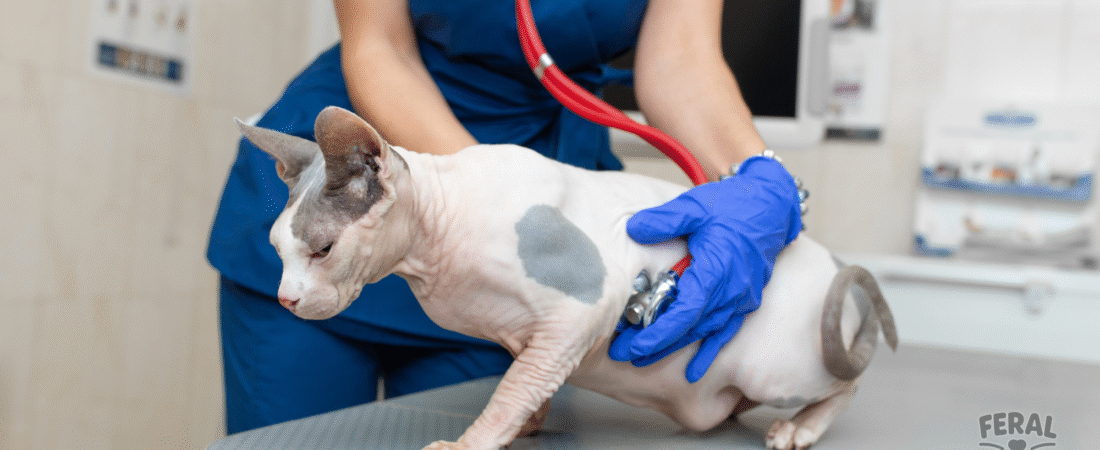Feline Leukemia Virus (FeLV) is one of the most serious and widespread viral diseases among cats. Often silent in its early stages, FeLV gradually weakens a cat’s immune system, leaving them vulnerable to infections, anemia, and even cancer. Understanding this virus, how it spreads, and how to care for positive cats is vital.
📌 What is Feline Leukemia Virus (FeLV)?
FeLV is a retrovirus, similar in behavior to HIV in humans, though species-specific (only cats are affected, humans and dogs are safe). Once in the body, the virus inserts itself into a cat’s DNA, causing lifelong infection. Some cats carry the virus without symptoms for months or years, while others become sick quickly.
🦠 How FeLV Spreads
FeLV is highly contagious through close social contact:
- Grooming & saliva exchange 🐾 (the virus is shed in saliva).
- Sharing bowls, litter boxes, or bedding.
- Nursing queens to kittens.
- Bite wounds (especially in outdoor, unneutered males).
Note: Unlike FPV, FeLV doesn’t survive long in the environment—usually only a few minutes to hours. The major risk comes from direct contact with infected cats.
🚨 Symptoms of Feline Leukemia Virus
Early stages may show no symptoms at all, but as immunity weakens, signs appear:
- Recurring respiratory or skin infections
- Fever 🌡️ and swollen lymph nodes
- Lethargy & weakness 💤
- Poor coat quality and weight loss 🐾
- Pale gums (anemia)
- Mouth inflammation (stomatitis, gingivitis)
- Diarrhea or chronic GI issues
- Infertility or miscarriages in queens
- Cancers like lymphoma in advanced stages
🔍 Diagnosis of FeLV
Your vet may recommend one or more tests:
- ELISA (SNAP test) – detects FeLV antigens in blood, results in minutes.
- IFA test – confirms ongoing infection by checking white blood cells.
- PCR testing – detects viral DNA inside cells for high sensitivity.
- Repeat testing may be needed for young kittens, as maternal antibodies can affect results.
💊 Treatment & Care for FeLV Cats
There is no cure for FeLV. Treatment focuses on managing symptoms, preventing secondary infections, and improving quality of life.
1. Prevent Secondary Infections:
- Prompt antibiotics for any bacterial infection.
- Regular veterinary checkups every 6 months.
2. Medications:
- Antivirals like interferon-omega or zidovudine (AZT) may help reduce viral load in some cats.
- Supportive meds – for anemia, immune support, or appetite stimulation.
- Pain control if cancer develops.
3. Diet & Nutrition:
- High-quality, protein-rich diet to support immunity.
- Wet food is often preferred for hydration.
- Avoid raw diets – FeLV‑positive cats are more vulnerable to food-borne illnesses.
⚠️ Warning: Never give cats human medications unless prescribed by a vet—many human antibiotics, painkillers, or antivirals are toxic for cats.
🏡 Home Care for FeLV Positive Cats
- Keep indoors only – prevents spreading to other cats and protects your cat from secondary infections.
- Stress-free environment – stress weakens immunity and triggers illness.
- Isolate from unvaccinated cats – FeLV positives can live safely with other FeLV+ cats but not with negatives unless all are vaccinated.
- Clean bowls, litter boxes, and toys regularly with soap and hot water (the virus dies quickly outside the body).
- Provide consistent routine, affection, and enrichment to keep spirits high.
🛡️ Prevention of FeLV
- Vaccination – an effective vaccine exists! Recommended for kittens, outdoor cats, or any cat exposed to unknown cats.
- Testing – screen all new cats before introducing them into your home.
- Limit exposure – keep cats indoors or supervise outdoor time.
- Spay/neuter – reduces territorial fighting (a common way FeLV spreads).
🌱 Quality of Life with FeLV
- Many FeLV‑positive cats live 2–5 years after diagnosis; some live much longer with proper care.
- Not all infected cats get sick immediately; some remain carriers for years.
- With a stable environment, regular vet care, and love, positive cats can still enjoy a happy, comfortable life.
- Quality, not length, of life becomes the main focus.
❓ FAQs About Feline Leukemia Virus
1. Can FeLV be cured?
No cure exists, but supportive care and antivirals can extend and improve quality of life.
2. Can humans or dogs catch FeLV?
No, FeLV is strictly a feline‑only virus.
3. Should FeLV positive cats be euthanized?
Not automatically. Many live happy lives for years. Euthanasia is only considered if the cat’s quality of life declines severely.
4. Can vaccinated cats still catch FeLV?
Rarely. The vaccine is highly effective but not 100%—still, it significantly lowers risk.
5. How do I care for a multi‑cat household with one FeLV‑positive cat?
The safest option is to keep FeLV+ cats separate or ensure all housemates are vaccinated and regularly tested.
💡 Final Thoughts
FeLV may sound frightening, but a positive diagnosis isn’t the end of the road. With vaccination, regular vet care, and loving home support, many FeLV‑positive cats live rewarding, joyful lives. The most powerful tools cat parents have are prevention and compassionate care.
✅ Key takeaway: Test, vaccinate, and protect—but don’t give up on FeLV cats. They deserve a chance at a loving, safe, and comfortable life.

